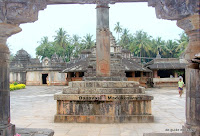
Normally the priests refrain from acting as a guide to the tourist, my wife took the initiative and requested the priest to spend a few minutes to explain the historical importance of this temple town.
Banavasi was known from the days of Emperor Ashoka. He sent his missionaries to Vaijantipura to spread the gospel of Buddha. The Shatvahana dynasty took over and reigned supreme for two centuries. Rashtrakutas too ruled over this territory for a period of 2 centuries. Sonda rulers too dominated over this territory for a brief period. The Chalukyas reigned with feudatories based in Banvasi, till Kadambas took over the reign. Thus the influence of all the dynasties is witnessed in Banavasi.
There was a huge fortress in Banvasi, which seems to have crumbled with elements of nature pounding the Fort walls. There are some signs of the fortress in the compound of the Madukeswara temple. The book written by George Moraes dwells into the history of Kadambas with the book title Kadamba Kula The is based on inscriptions deciphered.
Banavasi was also known as Jaladurga, since the vardha river flowed in three directions of the city. The mighty river is now tamed due to lesser rainfall. It probably covered the fourth side too with its tributaries.

Madukeswara temple was built by the Kadambas. It was in honour of the Linga which was honey coloured found on the banks of the river Vardha. The name signifies to honour the Lord of the mighty forests which was surrounding Banavasi. The temple seems to be dedicated to Lord Shiva, with the other sect claiming it was originally a Vishnu sect but later converted into Shiva.
There is a Nandi ( bull ) who is consort of Lord Shiva guarding the temple as it were. His eye is directed at both Shiva and Parvathi temples which is located sided by side. The walls of the temple is adorned with dancing postures of devadasis, who used to dance inside the premises to please the Lord. Interesting Lord Shiva is known as the destroyer of evil. Probably the dancers were pressed into service to cool the Lords temper.

Some innovative sculptures point to a combination of cow and horse on the façade of the temple. One has to closely observe this phenomenon. There is a huge 40 foot pillar with a small Nandi at the enterance of the temple. When one takes a circumbulation around the temple complex, one can find literally small gudi or mantaps housing the snake gods, Rama, Vishnu, Brahma, etc from the hindu mythology.
On some days a Brahmin family serve food to the devotees by charging a nominal fee of Rs 5 per head, and if one is generous he can donate the rest of the amount on voluntary basis. Since it was dusherra time when we visited we found good number of visitors.
There is a small private museum outside the temple complex, which is absolutely free. But as usual a donation box is kept for visitors to donate with their free mind. The museum inside the temple complex too houses a lot of sculptures recovered from surrounding areas and crumbled temples. It was interesting to note that a tiles merchant has rebuilt a small temple besides the main complex since he prospered in his business. There is another temple which is privately occupied due to encroachment.

The highlight of the collection is that of a Stone cot, which is beautifully carved. This cot was donated by the Sonda rulers to the treasury. The remanents of Buddhist relics and viharas are found in and around Banavasi. Thus Banavasi is also considered to be ancient holy city after Varnasi in terms of age. The secular fabric of the temple town is retained.
One can reach Banavasi from Jog falls via Siddapura, which is hardly 35 kms with well laid out road. Banavasi was known amongst the Greek Philosopher and geographer Ptolemy, Huen Tsang, Alberuni and even Kalidasa who wrote Meghdoota a love lyric, too has been inspired by Banavasi. Huen Tsang called Banavasi as Konkanpura. He mentions that Banavasi was filled with temples, Buddhist viharas and monasteries. A huge sandlewood Buddha was installed in one of the vihars. The forest surrounding Banavasi grew plenty of sandlewood trees.
The design of the temple clearly indicates that it is constructed with a view to protect the temple from heavy downpour in the region. The western ghats is rich with flora and fauna. The king cobra territory ranges from Agumbe ghat upto Banavasi. We ended our trip paying respect to the Lord and giving a small dakshina to the priest and the women serving the food.
Last time i was siris, i missed visiting this place , but next should make it to this place .
ReplyDeleteVery Interesting history, would love to visit this place someday!
ReplyDelete